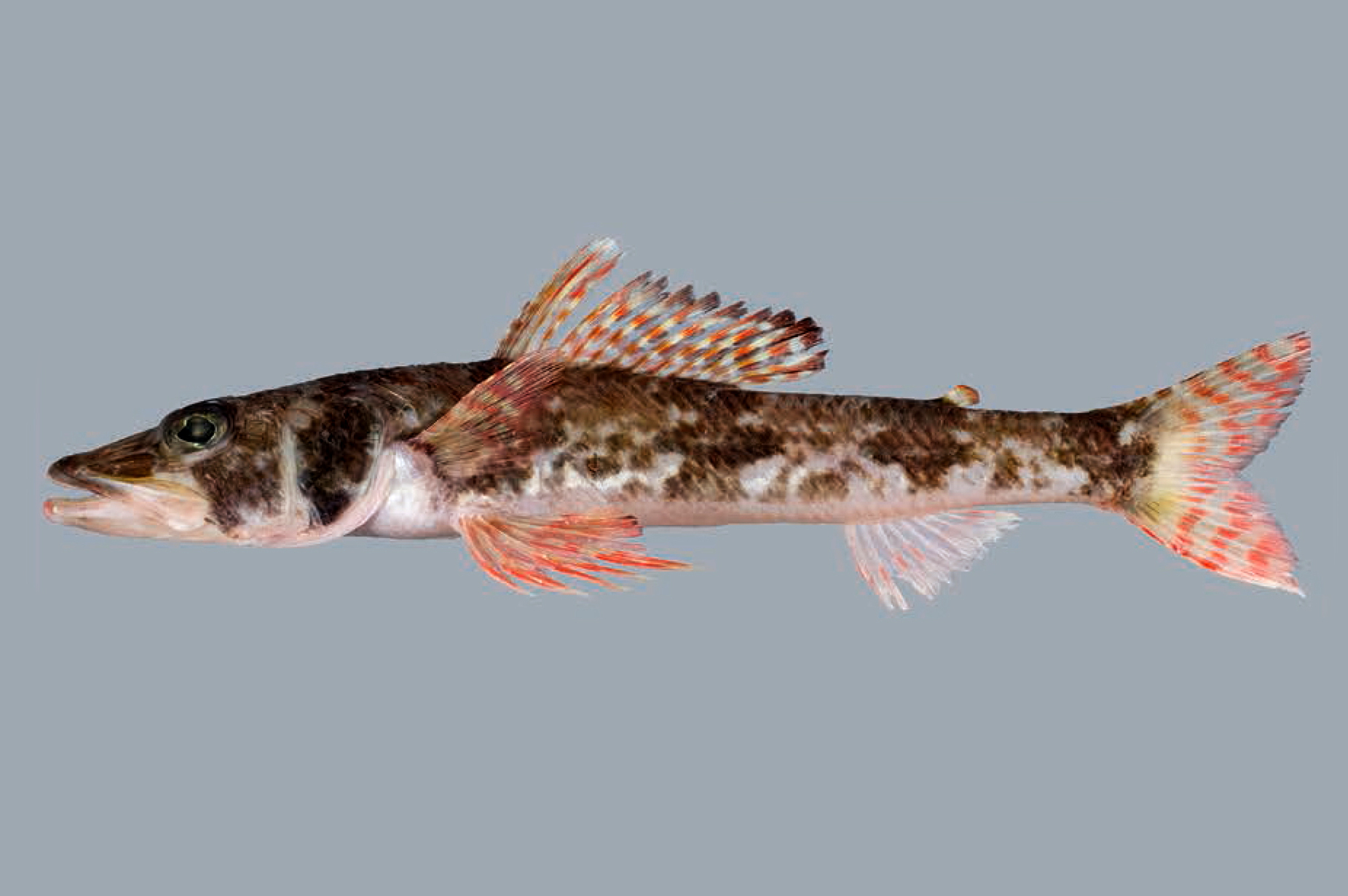- Classification
- ACTINOPTERYGII
- AULOPIFORMES
- AULOPIDAE
- Leptaulopus
- erythrozonatus
Duckbill Flagfin, Leptaulopus erythrozonatus Gomon, Struthers & Stewart 2013
Other Names: Fourfinger

Holotype of the Duckbill Flag, Leptaulopus erythrozonatus, NMNZ P.042518, 271 mm SL, from the Bay of Plenty, New Zealand. Source: Carl Struthers, Fig. 5C, in Gomon et al. (2013) Species Diversity 18: 141-161. License: All rights reserved
Summary:
A mottled dusky brown threadsail becoming paler below, with four irregular darker bands, narrow reddish-orange to brownish stripes on the dorsal fin, and a pale caudal fin with 4-5 narrow reddish bands across each lobe. The anus is positioned well in front of the anal-fin origin.
Cite this page as:
Bray, D.J. 2023, Leptaulopus erythrozonatus in Fishes of Australia, accessed 02 Jul 2025, https://fishesofaustralia.net.au/Home/species/4910
Duckbill Flagfin, Leptaulopus erythrozonatus Gomon, Struthers & Stewart 2013
More Info
|
Distribution |
Off Batemans Bay, New South Wales. Elsewhere the species occurs in New Zealand (Norfolk Ridge and North Island). Inhabits shelly and cobble areas in New Zealand. |
|
Features |
Dorsal fin 15-16; anal fin 10-11; Pectoral fin 12; Pelvic fin 9; Caudal fin 19-20; Lateral-line scales 44; Gill rakers 2-3 + 12 = 14-15; Vertebrae 44. Head and body elongate, slender, flattened ventrally; head moderate in length 3.1-34% SL; snout relatively long, somewhat depressed; anus well before anal-fin origin. Small caniform teeth present in broad bands on jaws, vomer, palatines and tongue. Dorsal fin originating just behind a vertical through pelvic-fin origin, fin moderately tall anteriorly, somewhat lower posteriorly; first two rays simple, rest branched, last split to base. Caudal fin forked. |
|
Fisheries |
Taken by recreational anglers using rod and line in New Zealand, and in demersal trawls. |
|
Similar Species |
Differs from Leptaulopus damasi in having 15-16 dorsal-fin rays (vs 13 or 14), 44 lateral line scales (vs 33–37), 44 vertebrae (vs 36), a smaller eye, and a longer, more depressed snout. |
|
Etymology |
The specific name erythrozonatus is a combination of the Greek erythros (= red) and zone (= belt), in reference to the distinctive red bands on the dorsal and caudal fins. |
|
Species Citation |
Leptaulopus erythrozonatus Gomon, Struthers & Stewart 2013, Species Diversity 18: 157, figs1, 2C, 5C, D. Type locality: Penguin Rise, Bay of Plenty, 37°24.29'S, 176°24.83'S, New Zealand, depth 130-140 m. |
|
Author |
Bray, D.J. 2023 |
|
Resources |
Duckbill Flagfin, Leptaulopus erythrozonatus Gomon, Struthers & Stewart 2013
References
Carpenter, K.E., Robertson, R., Matson, C. & Rivera Higueras, M. 2019. Leptaulopus erythrozonatus. The IUCN Red List of Threatened Species 2019: e.T123321739A123321829. https://dx.doi.org/10.2305/IUCN.UK.2019-3.RLTS.T123321739A123321829.en. Accessed on 23 January 2023.
Gomon, M.F., Stewart, A.L. & Struthers, C.D. 2015. Family Aulopidae. pp. 538-540 in Roberts, C.D., Stewart, A.L. & Struthers, C.D. The Fishes of New Zealand. Wellington : Te Papa Press Vol. 2 pp. 1-576.
Gomon, M.F., Struthers, C.D. & A.L. Stewart. 2013. A new genus and two new species of the family Aulopidae (Aulopiformes), commonly referred to as Aulopus, flagfins, Sergeant Bakers or Threadsails, in Australasian waters. Species Diversity 18: 141-161 https://doi.org/10.12782/sd.18.2.141
Roberts, C.D., Paulin, C.D., Stewart, A.L., McPhee, R.P. & McDowall, R.M. 2009. Checklist of New Zealand Chordata: living lancelets, jawless fishes, cartilaginous fishes and bony fishes, pp. 529– 538 in Gordon, D.P. (ed.) The New Zealand Inventory of Biodiversity. Vol. 1. Kingdom Animalia. Canterbury University Press, Christchurch, 568 pp (as Aulopodidae n. gen et n. sp.)
Shimizu, T. & Yamakawa, T. 1989. Review of the genera and western Pacific species of the Aulopidae. Third Indo-Pacific Fish Conference, Wellington, New Zealand, unpublished poster.


